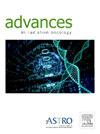Factors Associated With Early Discontinuation of Radiation Therapy: An Analysis of the National Cancer Database
IF 2.7
Q3 ONCOLOGY
引用次数: 0
Abstract
Purpose
Radiation therapy (RT) often involves multiple visits over weeks and may be discontinued before planned treatment completion. This analysis aims to identify clinical and socioeconomic factors that could serve as predictors of RT discontinuation.
Methods and Materials
Using National Cancer Database data from 2018 to 2019, we identified 749,135 cases treated with RT, chemoradiation (CRT), surgery with RT, or surgery with CRT that had information on radiation discontinuation. All patients were treated with curative intent. The variables assessed include age (18-<50, 50-<70, and ≥70), sex (male and female), race (White, Black, and Other), insurance status (private, Medicare/government, and Medicaid/uninsured), income level (<$46,277, $46,277-$57,856, $57,856-$74,062, and ≥$74,062), facility type (community, comprehensive community, academic/research, and integrated cancer network), Charlson-Deyo Comorbidity Score (0, 1, and ≥2), treatment type (RT, CRT, surgery with RT, and surgery with CRT), and primary tumor site. Reasons for RT discontinuation were evaluated. Univariable and multivariable logistic regression modeling was used to calculate the adjusted odds of RT discontinuation by clinical and socioeconomic factors.
Results
Of the 749,135 patients, RT was discontinued in 25,072 (3.3%) patients. The primary tumor sites include breast (36.6%), thorax (18.1%), genitourinary tract (13.2%), head and neck (11.4%), gastrointestinal system (10.9%), gynecologic system (6.0%), central nervous system (3.9%), musculoskeletal system (1.3%), and skin (0.7%). On multivariable analysis, older age, female sex, nonprivate insurance, lower income, treatment at community program facilities, multiple comorbidities, and CRT were independently associated with RT discontinuation. The reasons for RT discontinuation were patient decision (35.5%), contraindication because of patient risk factors (20.0%), toxicity (19.7%), patient expiration (13.8%), and family decision (3.0%).
Conclusions
This National Cancer Database analysis showed RT discontinuation rates correlated with clinical factors, including older age, multiple comorbidities, and CRT, and socioeconomic factors, including nonprivate insurance and lower household income.
早期停止放射治疗的相关因素:国家癌症数据库的分析
目的放射治疗(RT)通常需要在数周内多次就诊,并可能在计划治疗完成之前停止。该分析旨在确定临床和社会经济因素,可以作为RT停止的预测因素。方法和材料利用2018年至2019年国家癌症数据库的数据,我们确定了749,135例接受放疗、放化疗(CRT)、放疗手术或放疗手术的患者,这些患者都有停止放疗的信息。所有患者均以治愈为目的进行治疗。评估的变量包括年龄(18- 50岁、50- 70岁和≥70岁)、性别(男性和女性)、种族(白人、黑人和其他种族)、保险状况(私人、医疗保险/政府和医疗补助/未保险)、收入水平(46,277美元、46,277美元- 57,856美元、57,856美元- 74,062美元和≥74,062美元)、设施类型(社区、综合社区、学术/研究和综合癌症网络)、Charlson-Deyo合并症评分(0,1和≥2)、治疗类型(RT、CRT、RT联合手术和CRT联合手术)、原发肿瘤部位。评估停药的原因。采用单变量和多变量logistic回归模型计算临床和社会经济因素导致RT停止的调整几率。结果在749,135例患者中,25,072例(3.3%)患者停止了RT治疗。原发肿瘤部位包括乳房(36.6%)、胸腔(18.1%)、泌尿生殖系统(13.2%)、头颈部(11.4%)、胃肠系统(10.9%)、妇科系统(6.0%)、中枢神经系统(3.9%)、肌肉骨骼系统(1.3%)和皮肤(0.7%)。在多变量分析中,年龄较大、女性、非私人保险、收入较低、在社区项目设施接受治疗、多种合并症和CRT与RT停止独立相关。停药原因依次为患者自行决定(35.5%)、患者危险因素禁忌症(20.0%)、毒性(19.7%)、患者过期(13.8%)和家庭决定(3.0%)。结论:国家癌症数据库分析显示,放疗停药率与临床因素相关,包括年龄较大、多种合并症和CRT,以及社会经济因素,包括非私人保险和较低的家庭收入。
本文章由计算机程序翻译,如有差异,请以英文原文为准。
求助全文
约1分钟内获得全文
求助全文
来源期刊

Advances in Radiation Oncology
Medicine-Radiology, Nuclear Medicine and Imaging
CiteScore
4.60
自引率
4.30%
发文量
208
审稿时长
98 days
期刊介绍:
The purpose of Advances is to provide information for clinicians who use radiation therapy by publishing: Clinical trial reports and reanalyses. Basic science original reports. Manuscripts examining health services research, comparative and cost effectiveness research, and systematic reviews. Case reports documenting unusual problems and solutions. High quality multi and single institutional series, as well as other novel retrospective hypothesis generating series. Timely critical reviews on important topics in radiation oncology, such as side effects. Articles reporting the natural history of disease and patterns of failure, particularly as they relate to treatment volume delineation. Articles on safety and quality in radiation therapy. Essays on clinical experience. Articles on practice transformation in radiation oncology, in particular: Aspects of health policy that may impact the future practice of radiation oncology. How information technology, such as data analytics and systems innovations, will change radiation oncology practice. Articles on imaging as they relate to radiation therapy treatment.
 求助内容:
求助内容: 应助结果提醒方式:
应助结果提醒方式:


